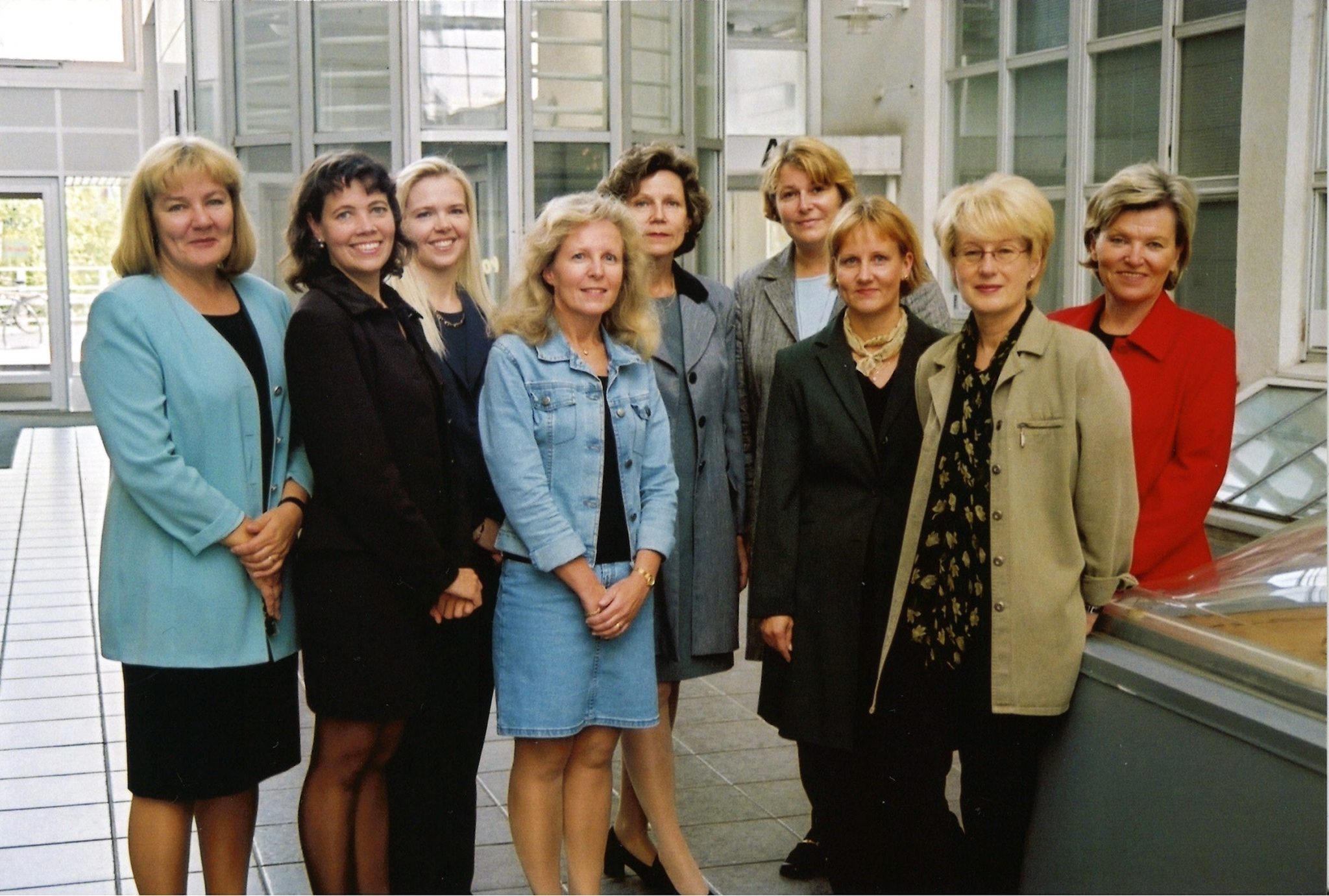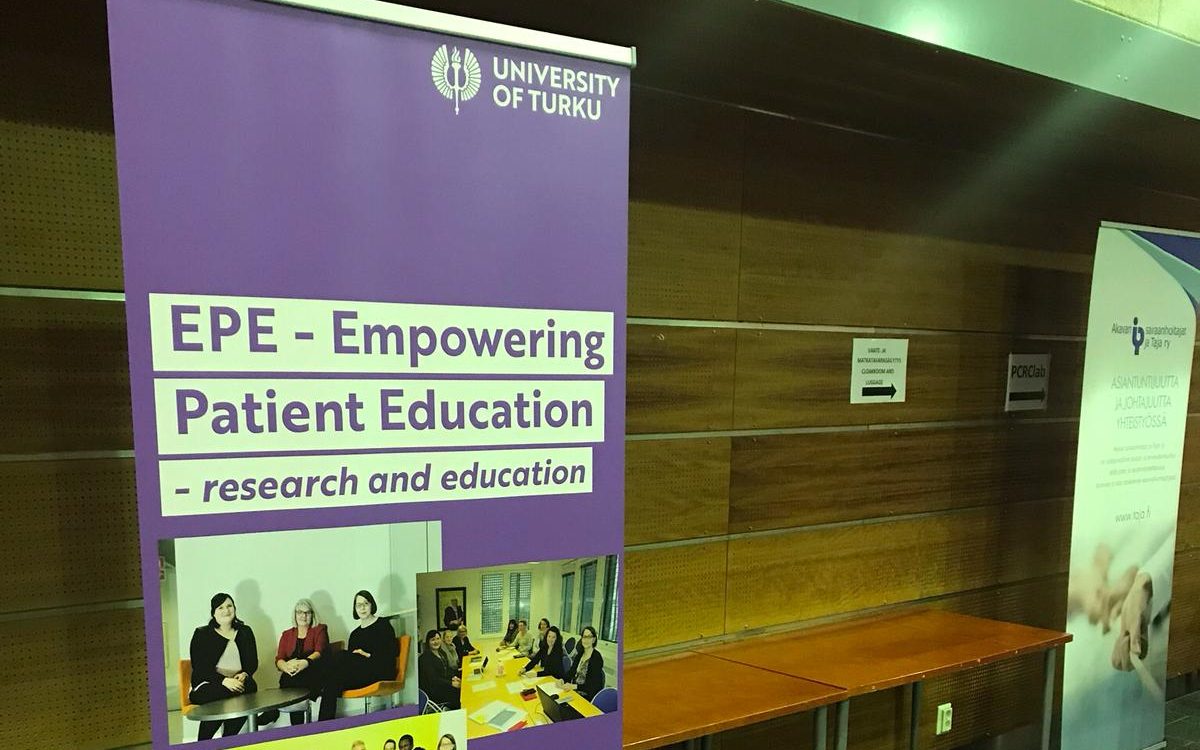Origin of the programme
The origin of the research programme is in late 1990s, in collaboration of the University of Turku, Department of Nursing Science, Turku University Hospital and Turku Polytechnics (also called Turku University of Applied Sciences).

Patient education Development Project 2000-2004
in collaboration between Turku University Hospital, Turku Polytechnic and The Department of Nursing Science, University of Turku
Helena Leino-Kilpi, Professor, PhD, RN, University of Turku
Sanna Salanterä, Head of Research, PhD, RN, University of Turku
Marja-Leena Pulkkinen, Nursing Director, PhD, RN, Turku University Hospital
Leena Elomaa, Senior Lecturer, PhD, RN, Turku Polytechnic
History
Research project has its roots in earlier studies in decision-making, evaluation of nursing care and nursing ethics (Biomed) in The Department of Nursing Science. Also, in 2000-2004 there was a development project among Turku University Hospital, Turku Polytechnic and The Department of Nursing Science, University of Turku, which in clinical practice indicated needs for further development of patient education. (see Johansson, K., Lehtikunnas, T., Leino-Kilpi, H., Salanterä, S., Ahonen, P., Elomaa, L., Iire, L., Moisander, M-L., Paltta, H., Pietilä, S. & Pulkkinen, M-L. 2001. Potilasopetus pontevasti paremmaksi – Potilasopetusta kehittävän hankkeen lähtökohdat ja perustietoa kartoitusvaiheen tuloksista. Varsinais-Suomen sairaanhoitopiirin kuntayhtymä Turun yliopistollinen keskussairaala. Hoitotyön julkaisusarja A:34 2001.)
Purpose and goal of the development project
The purpose of the patient education development project was to survey and evaluate patient education practices at Turku University Hospital. The ultimate goal was to develop evidence-based patient education to support patients’ own decision-making in their own care and improve their empowerment with a health problem at Turku University Hospital in Finland. The project had three phases: survey, intervention, and evaluation phase.
In the survey phase (2000-2001) written patient education material of Turku University Hospital (Salanterä et al. 2004), patient education practices of nurses and experiences of patients about patient education (Johansson et al. 2003) were analysed.
In the intervention phase (2002-2003) interventions were implemented in Turku University Hospital.
In the evaluation phase (2004-2005) the outcomes of nursing interventions and effective patient education practices were evaluated. A summative report of this project, see Pulkkinen et al 2006.
The criteria for developing the quality of written patient education material are in use in the Hospital District of Southwest Finland.
Outcomes of Patient Education in Ambulatory Surgery 2004-2006
Principal investigators:
Helena Leino-Kilpi, Professor, PhD, RN
Sanna Salanterä, Docent, PhD, RN
Others:
Katja Heikkinen, MNSc, RN, PhD candidate
Maija Hupli, Senior Lecturer, PhD, RN
Kirsi Johansson, MNSc, RN, PhD candidate
Anne Kaljonen, Statistician
Sirkku Rankinen, MNSc, RN, PhD candidate
Heli Virtanen, PhD, RN
Turku University Hospital
Annika Lindblom, Head of the Ward, RN
Tiina Leppänen, Head of Ward, MNSc, RN
Taina Nummela, RN
Leena Suominen, Nursing Director, RN
Ari Hiltunen, Doctor in Orthopaedics and Traumatology, Head of the Outpatient Clinic
The purpose was to examine outcomes of patient education in ambulatory surgery and the effects of preoperative educational sessions on patients empowerment. Furthermore, electronic patient education programs were designed.
Data (n=150) were collected at Turku University Hospital during 4/2004-9/2004 by structured questionnaires at six different times of the surgical procedure: 1) before preoperative education session, 2) after preoperative education session, 3) before surgical procedure, 4) on the first postoperative day, 5) on the third postoperative day and 6) two weeks after surgical procedure. Data consist of expected and received knowledge of hospital patients, patients’ evaluation of preoperative education sessions, the health status of their own and experienced distress before day surgical procedure, costs of illness, and possible connections with the health sector after surgical procedure.
Instruments used in data collection:
- EKhp (Expected Knowledge of Hospital Patients): before preoperative education session, created for this project (Rankinen, S., Salanterä, S., Heikkinen, K., Johansson, K., Kaljonen, A., Virtanen, H., Leino-Kilpi, H. 2007. Expectations and received knowledge by surgical patients. Journal for Quality in Health Care 19(2), 113-119: Leino-Kilpi, H., Johansson, K., Heikkinen, K., Kaljonen, A., Virtanen, H., Salanterä, S. 2005. Patient education and health related quality of life – surgical hospital patients as a case in point. Journal of Nursing Care Quality 20(4), 307–316.)
- EQ5D (The EuroQol Group 1990): before preoperative education session and 2 weeks after surgical procedure
- Kranz Health Opinion Survey (KHOS 1980): before the preoperative education session (Krantz et al. 1980)
- Patient’s evaluation of preoperative education session and of all received education: after preoperative education and after two weeks after surgical procedure, created for this study
- Patients experienced distress: after preoperative education session and before surgical procedure
- Patients symptoms and signs: before preoperative education session, on the first postoperative day, on the third postoperative day, and two weeks after surgical procedure, created for this project
- Contacts to healthcare: on the third postoperative day and two weeks after the surgical procedure, created for this project
- RKhp (Received Knowledge of Hospital Patient): two weeks after surgical procedure, created for this project (Rankinen, S., Salanterä, S., Heikkinen, K., Johansson, K., Kaljonen, A., Virtanen, H., Leino-Kilpi, H. 2007. Expectations and received knowledge by surgical patients. Journal for Quality in Health Care 19(2), 113-119: Leino-Kilpi, H., Johansson, K., Heikkinen, K., Kaljonen, A., Virtanen, H., Salanterä, S. 2005. Patient education and health related quality of life – surgical hospital patients as a case in point. Journal of Nursing Care Quality 20(4), 307–316.)
- Costs of day surgical procedure: two weeks after surgical procedure, created for this project
